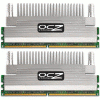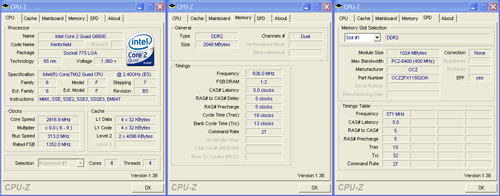- Qualcomm Launches Snapdragon 4 Gen 2 Mobile Platform
- AMD Launches Ryzen PRO 7000 Series Mobile & Desktop Platform
- Intel Launches Sleek Single-Slot Arc Pro A60 Workstation Graphics Card
- NVIDIA Announces Latest Ada Lovelace Additions: GeForce RTX 4060 Ti & RTX 4060
- Maxon Redshift With AMD Radeon GPU Rendering Support Now Available
OCZ 2GB Flex XLC PC2-9200

OCZ is on the top of their game, which is evident just by taking a look at their recent inventory. I will be taking a look at their latest high-end kit today, which utilize the new water-cooling capable heat spreaders.
Page 2 – Overclocking, Testing Methodology, Sandra
|
|
Even though this is one of the highest-end kits on the market, there is no fun in running any kit of ram at stock. None… absolutely NONE. I was curious to see how much overclocking headroom a 575MHz could possibly muster, but after reviewing Corsairs Dominator 9136 last week, I had an idea of what to expect, assuming that both kits use the same chips.
Well, these modules did not clock as high as the Dominators, but came very close. After a night of tweaking, the max stable OC I found was 625MHz with 5-5-5-18 timings. I need to make one thing clear though, as there seems to be a lot of confusion lately regarding what I consider to be a “max” overclock. I don’t conclude with an overclock setting unless it passes 1000% in MemTest for Windows as well as a full 3D Mark 06 run to prove that it’s fully 3D stable.
This kit -can- be clocked higher, but on my particular system it caused instabilities. I don’t see a point of running a kit so insanely high that it causes your computer to spontaneously reboot itself. Sure high numbers are fun, but it’s not practical.
I can say one thing though, you -will- want active cooling of some sort, because these spreaders get hot very quickly at 2.3v and above. Since these modules are meant to use 2.4v, it’s good to have that in your game plan. While they may run fine and dandy without a fan, I don’t feel particularly good knowing that the ram inside my computer is too hot to touch. I should also point out that I am talking about an 80mm or 120mm fan solution, as OCZs own XTC cooler in addition to Corsairs Airflow fan are too short to fit over the modules properly. You can sit these on top of the modules, but simply moving your computer will make it fall off.
That said, although DDR2-1250 was my personal max overclock, your situation might be different if you are not scared of applying higher than average voltage. The eVGA 680i tops out at 2.5v, which is a tad low when compared to other boards that hit 3.0v. After a lot of experimentation, I found that the memory scaled well with voltage, so extra dabs should help improve your overclock. OCZs in-house enthusiast, Tony Leach, has hit DDR2-1300 as a 100% stable overclock, but I don’t recall the voltage he needed to do so. DFI’s latest Crossfire board, the ICFX3200-T2R/G has insane capabilities, including (literally) intense voltage possibilities, so that might be the ideal board for this ram.
That said, here are the five stable settings I used (CL-tRCD-tRP-tRAS-tRC):
- 400MHz (DDR2-800), 1.9v, 4-4-4-12-13
- 500MHz (DDR2-1000), 2.1v, 4-4-4-12-13
- 533MHz (DDR2-1066), 2.3v, 4-4-4-12-13
- 575MHz (DDR2-1150), 2.4v, 5-5-5-18-13
- 625MHz (DDR2-1250), 2.5v, 5-5-5-18-13
Throughout all of our benchmarks regardless of what we are reviewing, testing is done in a clean and stand-alone version of Windows XP Professional with SP2. Prior to testing, these conditions are met:
- Desktop and scrap files are cleaned up, including emptying of recycle bin.
- No virus scanner or firewall is installed in the stand-alone installation.
- The stand-alone installation drive is completely defragged using Diskeeper 2007 Professional.
- All unnecessary programs are closed, so that Windows should have no more than 15 active processes running.
- Computer has proper airflow.
The testing rig used for today’s benchmarking is as follows:
- CPU: Intel Q6600 (2.4GHz – 2.85GHz)
- Motherboard: eVGA nForce 680i (P24 BIOS)
- Memory: OCZ Flex XLC 2GB PC2-9200
- Video: ASUS EN8800GTX 768MB
- Sound: Onboard HD Audio
- Storage: Seagate 7200.9 320GB
- Etcetera: Windows XP Professional w/ SP2
- Cooling: Corsair Nautilus 500
(Products linked are to our own reviews)
Most of the results listed deal with how all of our settings scaled, although there will be direct comparisons to other kits of ram as well.
On Core based systems, it’s always been rare to see a score in Sandra above 6,000MB/s, but that’s easily surpassed with stock speeds like this.

Obviously, thanks to the sheer clock speed, our 625MHz setting took the cake with 6651/6651. Yes, it was one of those times where both the Int and Float happened to be identical. You can see by comparing the middle and bottom results that frequency doesn’t play a large role in overall bandwidth. Even though the middle overclock had a full 133MHz above the bottom, it’s bandwidth was a mere 50MB/s better.
|
|
Support our efforts! With ad revenue at an all-time low for written websites, we're relying more than ever on reader support to help us continue putting so much effort into this type of content. You can support us by becoming a Patron, or by using our Amazon shopping affiliate links listed through our articles. Thanks for your support!






